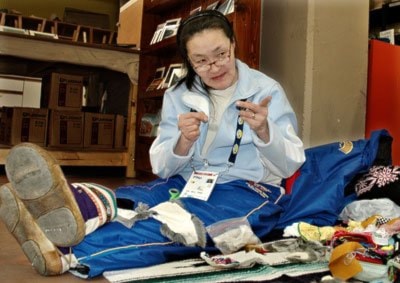Nunavut artist Gwen Tikhak feels hemmed in by Whitehorse’s trees and buildings.
“Too much trees for me, too much trees,” said the 40-something-year-old craftsperson who came to Whitehorse from Cambridge Bay as part of the Canada Winter Games cultural festival.
“We live in a flat country where there’s no trees, but the weather is same as home, make us feel at home,” she said with a hearty laugh.
Along with seven other artists from Nunavut, eight from the NWT and 14 from the Yukon, Tikhak will be demonstrating her art and selling her dolls at the ATCO Place tent over the next week, starting Wednesday.
There’s also a schedule packed with performers from northern and southern Canada as part of the Games’ cultural component.
On Saturday afternoon, Tikhak and her auntie, a small hunched woman she calls her elder, were sitting on the floor of the Arts Underground studio sewing.
Their materials — swatches of fabric and skin — were spread out on the blanket beside them.
To make the crafts, she hand sews pieces of brightly patterned materials together and fills the insides with cotton stuffing.
Some of the dolls have different coloured dresses; each has a tan face with the eyes, nose and mouth embroidered in brown thread.
She has a heap of half-finished dolls piled on the floor before her.
Tikhak calls them “Effie dolls,” in tribute to a friend back home.
“She passed away many years ago and she was making these little dolls so I’m trying to keep it up,” she said with a toothless grin.
“She died before I was even known to sew.”
So Tikhak picked up the craft to keep the tradition of doll making alive.
She’s been making the crafts for three years and recently completed her 2,000th one. She sells the dolls for about $40 a piece in galleries and stores in Nunavut.
“I get a lot of doll collectors — they like to see a lot of different dolls from different countries,” she said.
Tikhak answered questions in English, then switched effortlessly to Inuktitut to talk to her auntie, who was sitting beside her with a hunched back, sewing together mittens.
Wielding a razor-sharp, bone-handled ulu expertly, Tikhak cleaved the instrument through a piece of soft grey rabbit fur.
“This is only for cutting out fur like this; we don’t use it for eating,” she explained.
“It’s specially made for sewing.”
She cut the fur in doughnut shapes and draped the shapes over a doll’s faces making a ring-shaped hood.
“I’m here for three weeks; I’m going to do my sewing and maybe go watch some sports.
“I just love sports, especially when I saw Hayley — I scream really loud.
“I love any kind of sports — curling, hockey, speed skating — any kind of sport,” she said.
She is staying at the pan-northern village, located at the Gadzoosdaa residence, with other visitors of all ages.
“It’s pretty good I guess, we got curfew at 11 o’clock,” she added with a laugh.
